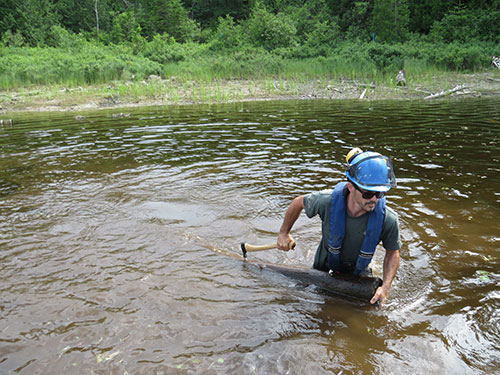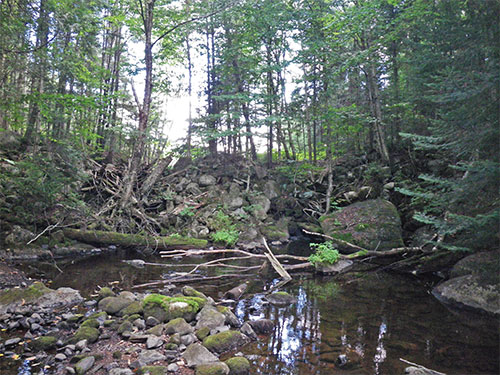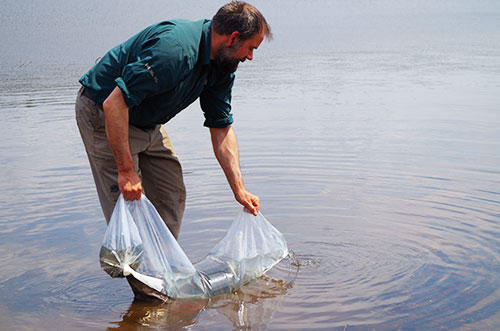
Three phases of restoration
La Mauricie National Park
The aquatic ecosystem conservation and restoration project at La Mauricie National Park is in line with Parks Canada’s mission to understand, protect, and revitalize ecosystems to preserve their ecological integrity by returning them to their natural state. Concretely, this project comprises three phases:
- Removal of the logs that have accumulated on the shorelines and lakebeds
- Restoration of the lakes’ and wetlands’ water regime by dismantling the old log driving structures
- Restoring brook trout populations by preserving the population’s genetic integrity
Log removal

Removing the logs that have accumulated on the shorelines and lakebeds constitutes a concrete step toward restoring the aquatic ecosystems. Team members gather the logs one by one directly on the lake shores or on boats, employing the same tools used by log drivers a century ago, i.e. pike poles and pickaroon.
Over the course of 15 years, more than 100,000 logs were removed from 20 lakes. These restoration efforts not only help improve the health of the aquatic ecosystems, but also benefit visitors, who can once again enjoy the Park’s beaches.
It should be noted that there are no roads providing access to La Mauricie National Park’s backcountry. Team members working on this task must therefore take shelter in a temporary fieldwork camp that is only accessible by crossing four lakes and three kilometres of portage trails. They bring their equipment and food for the week with them, while in the winter, heavier equipment is brought in by snowmobile or even seaplane.
Water regime restoration


The water regime of the lakes, wetlands, and waterways is restored by dismantling the old log driving structures, like the splash dams. First, to document and better understand these vestiges, archaeological surveys are conducted on the structures and their contribution to increased water levels. Next, the dams are dismantled, which requires the removal of a large quantity of the materials used to construct them.
Lake Dauphinais is a good example of the restoration of the water regime. Over 150 tonnes of rock were extracted stream bed. The dismantling took three months of work and required the use of machinery.
Thanks to this project phase, the water regime of the 20 lakes was restored. This work is helping to mitigate shoreline erosion and benefits several animal species, including the brook trout, as free passage between certain lakes has been re-established.
Brook trout restoration

Restoring brook trout populations requires rigorous environmental analyses. First, the abundance of each fish species in the lakes must be studied. When a brook trout population is found to be under threat, we capture the remaining fish to allow them to reproduce in captivity, free from competition and predation, thereby preserving the population’s genetic integrity.
Afterwards, when the brook trout population nears extinction, we re-establish their place in the ecosystem by using a biodegradable biological agent to eliminate the non-native fish species. In addition to being the only effective solution, this agent decomposes rapidly in the environment, generally within 20 days.
Finally, we reintroduce the fry born in captivity into the lake, which is now free of exotic species. This way, they become the lake’s only species of fish, as was originally the case.
Until now, each lake’s brook trout population was found to be genetically distinct from that of neighbouring lakes. After the last ice age, the bodies of water became isolated, allowing the brook trout populations to evolve independently.
Over the course of 15 years, 52,600 fry were raised in fish farms and released into the lakes. In total, brook trout habitats were restored in 14 lakes.
- Date modified :